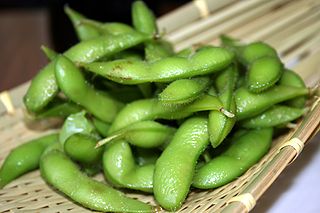
Edamame is an East Asian dish prepared with immature soybeans in their pods, which are boiled or steamed, and may be served with salt or other condiments. The dish has become popular across the world because it is rich in vitamins, dietary fiber, and isoflavones. When the beans are outside the pod, the term mukimame is also sometimes used in Japanese. Edamame are a common side dish in Japanese cuisine and as an appetizer to alcoholic beverages such as beer or shōchū. As an ingredient, edamame are found in both sweet and savory dishes such as takikomi gohan, tempura, and zunda-mochi.

The kidney bean is a variety of the common bean named for its resemblance to a human kidney.
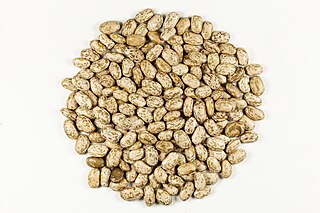
The pinto bean is a variety of common bean. In Spanish they are called frijoles pintos. It is the most popular bean by crop production in Northern Mexico and the Southwestern United States, and is most often eaten whole, or mashed and then refried. Prepared either way, it is a common filling for burritos, tostadas, or tacos in Mexican cuisine, also as a side or as part of an entrée served with a side tortilla or sopaipilla in New Mexican cuisine.

Cress, sometimes referred to as garden cress to distinguish it from similar plants also referred to as cress, is a rather fast-growing, edible herb.

The black gram or urad bean is a bean grown in South Asia. Like its relative, the mung bean, it has been reclassified from the Phaseolus to the Vigna genus. The product sold as black gram is usually the whole urad bean, whereas the split bean is called white lentil. It should not be confused with the much smaller true black lentil.

The winged bean, also known as cigarillas, Goa bean, four-angled bean, four-cornered bean, manila bean, princess bean, star bean, kamrangi bean, pea, or dragon bean, is a tropical herbaceous legume plant.

Vigna aconitifolia is a drought-resistant legume, commonly grown in arid and semi-arid regions of India. It is commonly called mat bean, moth bean, matki or dew bean. The pods, sprouts and protein-rich seeds of this crop are commonly consumed in India. Moth bean can be grown on many soil types, and can also act as a pasture legume.

The asparagus bean is a legume cultivated for its edible green pods containing immature seeds, like the green bean. It is also known as yardlong bean, pea bean, long-podded cowpea, Chinese long bean, snake bean, bodi, and bora. Despite the common name of "yardlong", the pods are actually only about half a yard long, so the subspecies name sesquipedalis is a more accurate approximation.

Green beans are young, unripe fruits of various cultivars of the common bean, although immature or young pods of the runner bean, yardlong bean, and hyacinth bean are used in a similar way. Green beans are known by many common names, including French beans, string beans, and snap beans or simply "snaps." In the Philippines, they are also known as "Baguio beans" or "habichuelas" to distinguish them from yardlong beans.

The black turtle bean is a small, shiny variety of the common bean especially popular in Latin American cuisine, though it can also be found in the Cajun and Creole cuisines of south Louisiana. Like all varieties of the common bean, it is native to the Americas, but has been introduced around the world. It is also used in Indian cuisine, Tamil cuisine, where it is known as karuppu kaaramani and in Maharashtrian cuisine, where it is known as kala ghevada. It is widely used in Uttrakhand, where it is also known as "bhatt". It is a rich source of iron and protein. The black turtle bean is often simply called the black bean, although this terminology can cause confusion with at least three other types of black beans.

Celtuce, also called stem lettuce, celery lettuce, asparagus lettuce, or Chinese lettuce, is a cultivar of lettuce grown primarily for its thick stem or its leaves. It is used as a vegetable. In China, the family is informally called woju, which is also the name of a cultivar. It is especially popular in both China and Taiwan, where the stem is interchangeably called wosun or qingsun(青筍; 青笋; qīngsǔn).

The red cabbage is a kind of cabbage, also known as Blaukraut after preparation. Its leaves are coloured dark red/purple. However, the plant changes its colour according to the pH value of the soil due to a pigment belonging to anthocyanins.
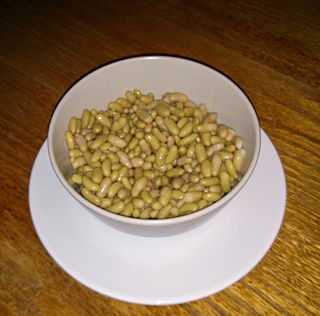
The flageolet bean is a variety of the common bean originating from France. The flageolet is picked before full maturity and dried in the shade to retain its green color. The bean is small, light green, and kidney-shaped. The texture is firm and creamy when shelled and cooked. The flageolet bean is grown in California.
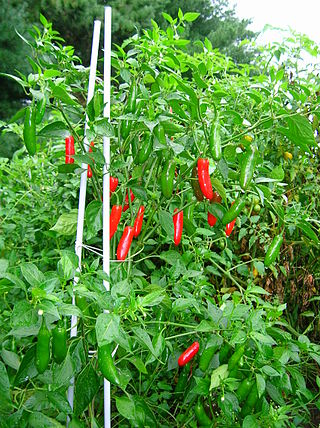
The serrano pepper is a type of chili pepper that originated in the mountainous regions of the Mexican states of Puebla and Hidalgo. The Scoville rating of the serrano pepper is 10,000 to 25,000. The name of the pepper is a reference to the mountains (sierras) of these regions. The pepper is commonly used to make hot sauces.
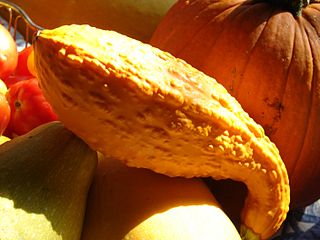
Crookneck squash, also known as yellow squash, is a cultivar of Cucurbita pepo, the species that also includes some pumpkins and most other summer squashes. The plants are bushy and do not spread like the plants of winter squash and pumpkin. Most often used as a summer squash, it is characterized by its yellow skin and sweet yellow flesh, as well as its distinctive curved stem-end or "crooked neck". It should not be confused with crookneck cultivars of Cucurbita moschata, such as the winter squash 'Golden Cushaw', or the vining summer squash 'Tromboncino'. Its name distinguishes it from another similar-looking variety of C. pepo, the straightneck squash, which is also usually yellow. There is one similar non-edible C. pepo variety: C. pepo var. ovifera.
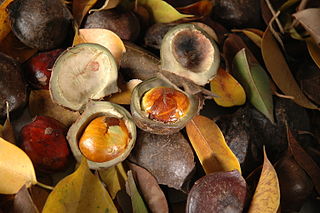
Archidendron pauciflorum, commonly known as djenkol, jengkol or jering, is a species of flowering tree in the pea family, Fabaceae. It is native to Southeast Asia, where the seeds are also a popular dish. They are mainly consumed in Indonesia, Thailand, Myanmar, and Vietnam, prepared by frying, boiling, or roasting, and eaten raw. The beans are mildly toxic due to the presence of djenkolic acid, an amino acid that causes djenkolism. The beans and leaves of the djenkol tree are traditionally used for medicinal purposes, such as purifying the blood. To date, djenkol is traded on local markets only.

The cranberry bean is a variety of common bean first bred in Colombia as the cargamanto. It is also known as the Borlotti bean, Roman bean, romano bean, saluggia bean, gadhra bean orrosecoco bean. The bean is a medium to large tan or hazelnut-colored bean splashed or streaked with red, magenta or black.
The Appaloosa bean is a cultivar bean variety of the species Phaseolus vulgaris.
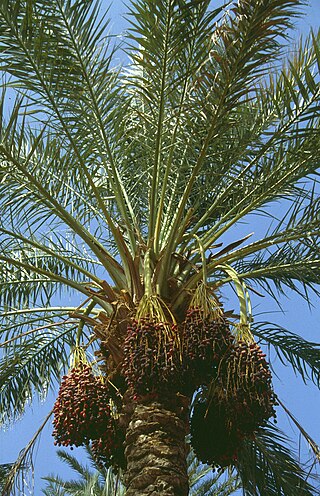
Mazafati is a cultivar of the palm date. It is a dark, soft, fleshy and sweet date of medium size, about 2.5–4.5 cm (1–2 in) with a relatively high moisture content of between 32 and 35%, varying with the time of harvest and the location of the grow.

Dragon tongue bean, or dragon tongue shelling bean, is young green bean of cranberry bean, pinto bean in the species Phaseolus vulgaris.



















